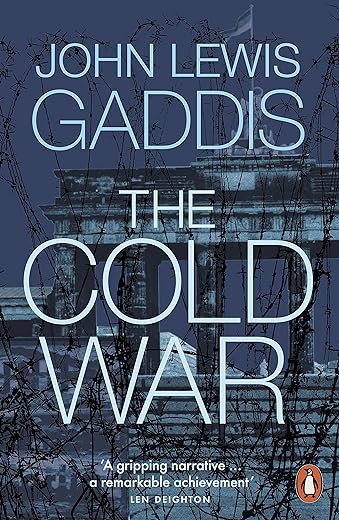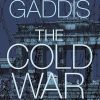The Cold War
£10.40£12.30 (-15%)
A brilliantly arresting historical work, John Lewis Gaddis’s The Cold War takes us as never before to the time when the world stood on the brink of destruction.
In 1945 war came to an end. But a whole new terror was only just beginning…
Here is the truth behind every spy thriller you’ve read: why America and the Soviet Union became locked in a deadly stalemate; how close we came to nuclear catastrophe; what was really going on in the minds of leaders from Stalin to Mao Zedong, Ronald Reagan to Mikhail Gorbachev, how secret agents plotted and East German holidaymakers helped the Berlin Wall fall. It is a story of crisis talks and subterfuge, tyrants and power struggles – and of ordinary people changing the course of history.
‘Gripping’
Len Deighton
‘Superb … brimful of racy incident’
Independent on Sunday
‘A lively and readable history’
The Times
‘Force 9 on the Richter scale’
Spectator
John Lewis Gaddis is the Robert A. Lovett Professor of History at Yale University, and ‘the dean of cold war historians’ (The New York Times). He is the author of numerous books, including Security and the American Experience, the book recently pressed on his cabinet and senior security staff by President Bush.
Read more
Additional information
| Publisher | 1st edition (25 Jan. 2007), Penguin |
|---|---|
| Language | English |
| Paperback | 352 pages |
| ISBN-10 | 0141025328 |
| ISBN-13 | 978-0141025322 |










by Mr. M. Sanders
There is some interesting writing here but sadly some key points of the Cold war are left out such as :
The retention of Ukrainians in German uniform by Churchill in 1945 contributed to the cold war, leading to numbers reported as over 20,000 British, American and European prisoners of war being held by Stalin as hostages after VE day and never returned to the West.
That US Prisoners of war were never returned nor was investigation made after sightings and names were given to the US government by German and other nationals released from Gulag captivity. That thousands of US and Allied prisoners of war were ‘written off’ and no efforts made to politically intervene and negotiate their release.
That on average 1 US serviceman a year was kidnapped in Berlin and never released.
That Korean war prisoners were not all released after that war ended, some were shipped to Russia as were many aviators who were shot down on surveillance missions from the 1950’s onwards.
That nuclear weapons were deployed to Guam in the Korean war, but not used.
No mention of BRIXMIS or the Soviet counterpart SOXMIS who monitored military equipment in the respective zones of Germany.
No mention that Rudolf Hess was in Spandau prison, which gave the Soviets ‘legitimacy’ to maintain troops in Berlin, as they mounted guard on Hess in rotation with the other powers.
The Portland affair is not mentioned – where British submarine secrets were passed to Gordon Lonsdale a spy whose real name was Konan Molody.
George Blake – the Dutch man who was with the British forces in WW2 and was taken prisoner in the Korean War spied for Russia until he was arrested in 1962. Blake’s treachery allowed hundreds of agents to be captured and killed and comprised the BRIXMIS work. His spying caused untold damage to the West.
The Greenham Common airbase which caused controversy in 1983 is not mentioned.
That the Soviets held back and restricted East German people so that the country became reliant on Soviet financial handouts and was not the socialist miracle that the GDR maintained. Or that the Soviets robbed the GDR of persons with useful skills and also machinery after WW2, having to return them as the GDR started to fail and become a country of old people and children which led to the Berlin wall construction as they came disillusioned by the Socialist utopia that never existed. for example.
On the other side though, there is some interesting information, but his students have I feel been shortchanged by the lack of inclusion of the information I have mentioned here, all of which is in the public domain.
by Chris Chalk
As the Berlin war was being torn down I was a few months past my 10th birthday. Do I remember anything about it? Do I hell. However, if I was to recall those momentous moments when East and West collides I might have asked myself how this fabled event came to pass – what caused its construction, more importantly what caused its destruction?
These, amongst many other questions, are the points that John Lewis Gaddis seeks to answer in his book on the Cold War. Looking at the names on the back cover – including a guardedly gushing Henry Kissinger, and the author of Gulag – a History Anne Applebaum – you can see what high esteem the author is held in amongst is peer group.
However, I am not one of his peer group – back to the point my knowledge of the cold war is sketchy at best. I have heard of the Bay of Pigs landing, I have heard of Richard Nixon and Watergate, I have even heard of the Cuban missile crisis but I have never seen them connected in such away as JLG manages in this book.
Most pointedly of all for me he highlights how differing regimes can work together and how manipulation of one by another rarely results in long term sustainable economies or every day lives. He doesn’t shy away from highlighting America’s faults during this conflict although he is more scathing of the Russians – to the victor the spoils and all that. It was thoroughly fascinating to see him write about regime change in Iran, Afghanistan and Chile – look how they turned out. You can draw real parallels from what happened between 1950 and 1990 with what is happening now in the Middle East – one day humanity just might learn.
For the novice to this subject – such as myself – I found this is a fascinating guide to a troubled time, the style of writing is not dry and very easy to read, unlike most historians he doesn’t get bogged down in long flowery, overly academic language that is so tiresome on the eye. For the more advanced reader take this opportunity to do as Kissinger himself does on the back cover and debate the points raised. To all though I would suggest that this is an excellently written, fascinating narrative of the time.
by Pemmers
Reviews for this book suggested it was very conservative and one sided, so I was shocked while reading it at the lack of propaganda and obvious bias. It’s true that Gaddis uses the so called “great man view of history” (although I am reticent to use this phrase since Margaret Thatcher, who Gaddis discusses, was, great or not, a women), however he intersperses this with the feelings and politics of the general populace and I never got the sense that he was suggesting, especially near the end of the Cold War, that the people did not play as much a role as the leaders. When at times Gaddis is potentially biased most of the time he makes up for this by highlighting the good elements of a certain leader without implying that we need agree that the leader was good as a whole. He is certainly not one sided in his treatment of Russian leaders; at least as much time is devoted in the second half to Gorbachev as to Reagan and Thatcher. Lastly, Gaddis specifically states in his introduction that this book is a simplification and streamlining of his, and others, earlier work, aimed at students. If you want a very detailed and completely comprehensive view of the Cold War then other books would serve this purpose better.